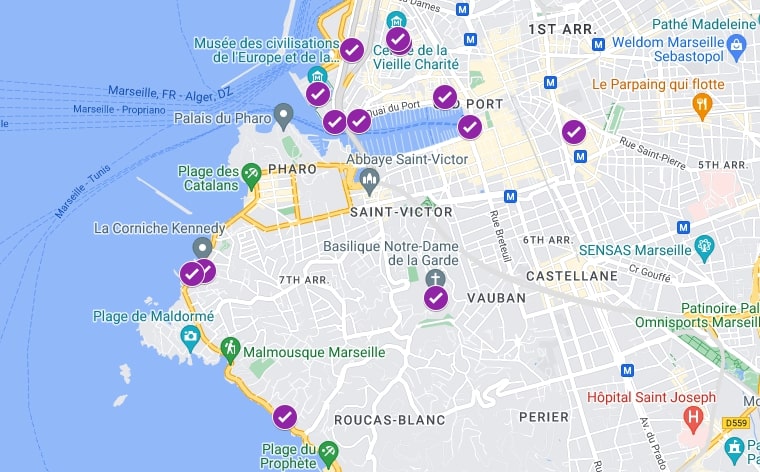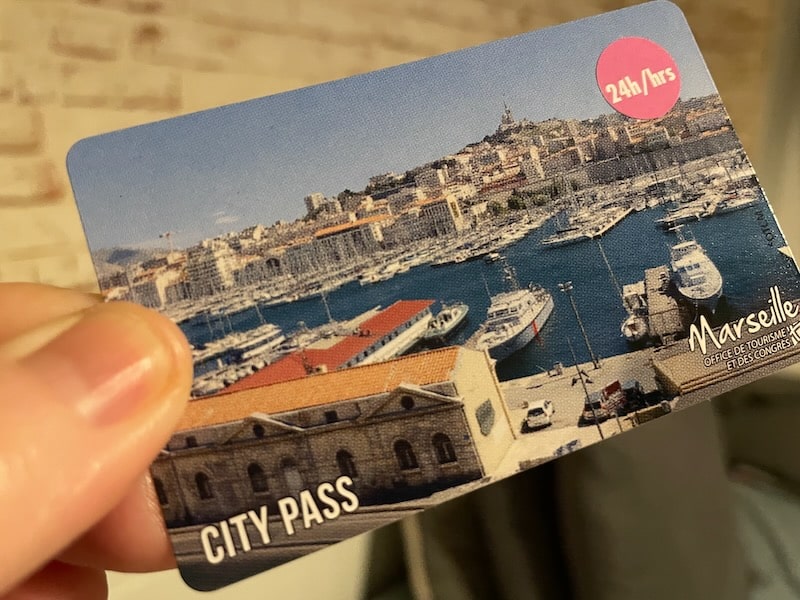Unsure about your French table manners? Click Here to download > > How to avoid these 10 food etiquette mistakes !
- Home ›
- Destinations ›
- Southern France ›
- One Day in Marseille
How To Make The Best Of One Day In Marseille
Published 14 January 2025 by Leyla Alyanak — Parisian by birth, Lyonnaise by adoption, historian by passion
Even if you only have one day in Marseille, it's plenty of time to see the top sights of the city. I've prepared a one-day itinerary for you, along with plenty of suggestions to get the most out of a perfect 24 hours in Marseille.
It is a stunning city by any standard, the Old Port of Marseille gracefully lined with low-rise buildings and hundreds of small boats mixed in with luxury yachts, the kind of view that will stick in your mind until you finally give in and rush to reserve your ticket.
Up on the hill, a majestic basilica stands guard. In the distance, a fortress on a rock at sea inspired one of the outstanding historical novels of all time.
Marseille is a beauty.
It's also, in many ways, one of France's most compelling cities. You'll be beating the crowds as visitors rush past to visit other tourist hot spots in southern France, leaving you to enjoy an unusual, energetic and historic port city.
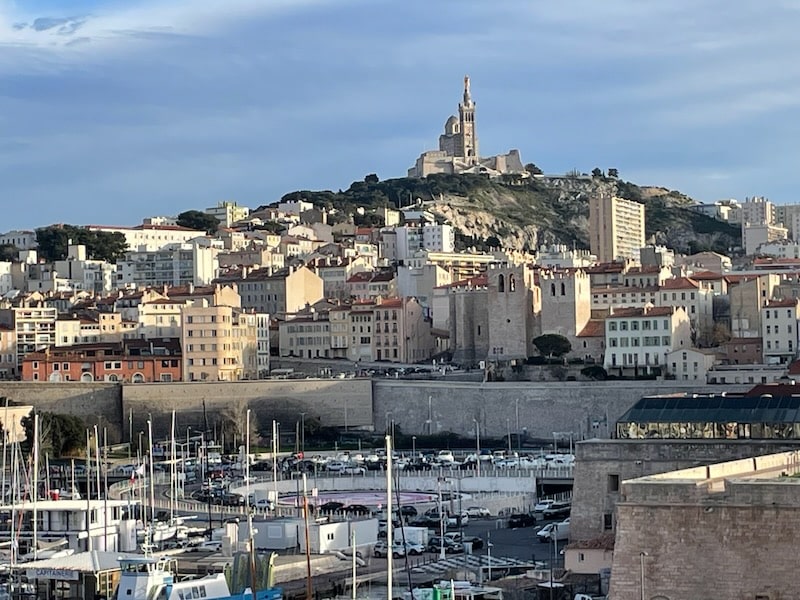
I spent ten days in Marseille not long ago but I live in France and the city is just over three hours by train from my doorstep.
Most people don't have that much time. Often, the city is a one-day cruise ship stop along the Mediterranean Sea, or a one-day trip if you happen to be nearby, say in Avignon or the Luberon.
One day may not be much, but it is enough to see the high points of the city. Here, let me show you.
NOTE: Pages on this site may contain affiliate links, which support this site. See full Privacy Policy here.
The city's story begins around 6000 BCE, when a group of Greek traders from Phocaea − modern-day Turkey − went off to find a new home, ending up on the coast of southern Gaul.
A local tribe called the Ligurians lived there, and the king's daughter, Gyptis, got to choose her husband by offering him a glass of wine during a ceremony. The happy recipient was none other than Protis, leader of the Phocaeans. They married and together founded Massilia, the city we now know as Marseille.
By the time Julius Caesar launched his conquest of Gaul in 58 BCE, Massalia had already established itself as a vital link between the Greek and Roman worlds. Much of that Greek heritage faded, and Marseille prospered as a Roman city until it was captured by the Visigoths and eventually declined, annexed by the County of Provence in the 10th century.
Many ups and downs followed, including two plagues, invasions and partial destruction during World War II. Today, Marseille is a melting pot, which is part of its problem but also part of its attraction.
And now, ready to spend 1 day in Marseille? Here's a quick overview of what your itinerary could look like.
MARSEILLE ITINERARY HIGHLIGHTS
- 6:30 AM: Sunrise at Notre-Dame de la Garde
- 8:00 AM: Morning coffee at La Caravelle
- 9:00 AM: Explore Le Panier district
- 10:45 AM: Visit Mucem and the Fort St. Jean
- 12:30 AM: Lunch at Cours Julien
- 2:00 PM: Boat trip to Château d'If
- 4:30 PM: Leisurely stroll along Vieux-Port, visit soap museum or Musée Longchamp
- 7:00 PM: Dinner at Chez Fonfon
- 9:00 PM: Stroll along the Corniche Kennedy back to town
Detailed guide to spending one day in Marseille
A word of caution: this is a PACKED itinerary. Some of you may want to brave it. Others may just choose a few things and explore those more in depth. You can mix and match at will – you don't have to do it all!
Notre-Dame de la Garde
Begin your day at the iconic basilica, Notre-Dame de la Garde, to watch a breathtaking sunrise over Marseille. Affectionately known as "La Bonne Mère" (The Good Mother), this beautiful building has been a symbol of protection for Marseille's inhabitants since its consecration in 1864.
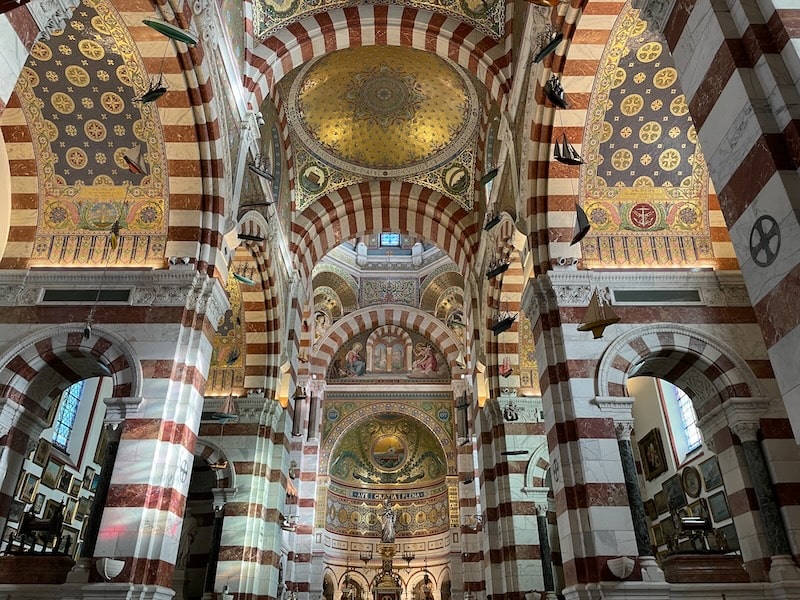 The basilica's gilded interior, well worth exploring ©OffbeatFrance
The basilica's gilded interior, well worth exploring ©OffbeatFranceThe basilica's Neo-Byzantine architecture, designed by Henri-Jacques Espérandieu, is striking, whether you like this style or not.
From almost anywhere in Marseille, not only can you see the basilica but also the bell tower with a gilded statue of the Virgin Mary holding the infant Jesus. The statue, by the way, happens to be hollow, and a staircase inside leads up to her eyes, although this is closed to the public.
The site started as a 13th-century chapel which was fortified in the 16th century to defend the city, but eventually destroyed during the French Revolution.
Inside, the basilica is adorned with intricate mosaics and ex-votos, tokens of gratitude from sailors and fishermen who believe the Good Mother watched over them at sea.
The panoramic views alone make a visit worthwhile...
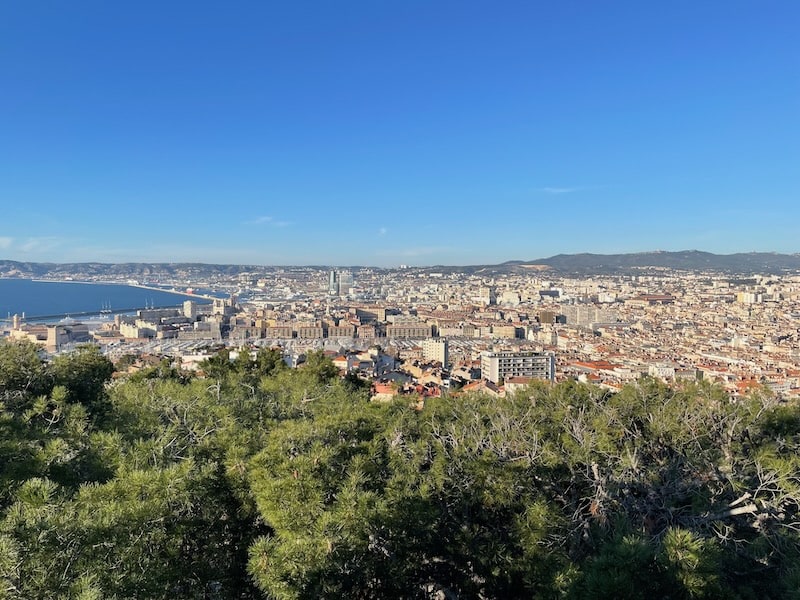 One of the panoramic views from the basilica over Marseille ©OffbeatFrance
One of the panoramic views from the basilica over Marseille ©OffbeatFranceGiven the early hour, public transport may be limited (the bus starts at 7am). Consider arranging a taxi or using a rideshare service like Bolt or Uber to reach the basilica.
By the time you leave, the bus should be running. It's Number 60 and leaves from the small square at the basilica's entrance. Get off at Vieux Port. La Caravelle is close by.
Another option is to walk down from the basilica. But a word of warning: this is going to be a long day so you might want to save your energy!
Morning coffee at La Caravelle
If you rushed out to catch the sunrise and are desperate for coffee, head for La Caravelle. It's a historic bar, with a maritime vibe, a favorite with locals and visitors since the 1920s. It's on the first floor of the Hôtel Belle-Vue, so you'll get great views of the harbor and can watch the city wake up.
You can even have a full breakfast here but make it quick!
Le Panier District
A few minutes' walk from La Caravelle and you'll be in the heart of Le Panier, Marseille's oldest neighborhood, founded by the Phoceans.
This is one of the most popular parts of the city, almost too much so, when crowds overrun its narrow streets in search of colorful façades, artisan boutiques and galleries.
By going off season, you'll enjoy the area even more, and without thousands of tourists, it will also feel far more authentic.
Much of Le Panier looks as it has for centuries, although part of it was destroyed by Nazi forces during World War II and rebuilt in the mid-19th century. Still, the heart of Le Panier remains unchanged.
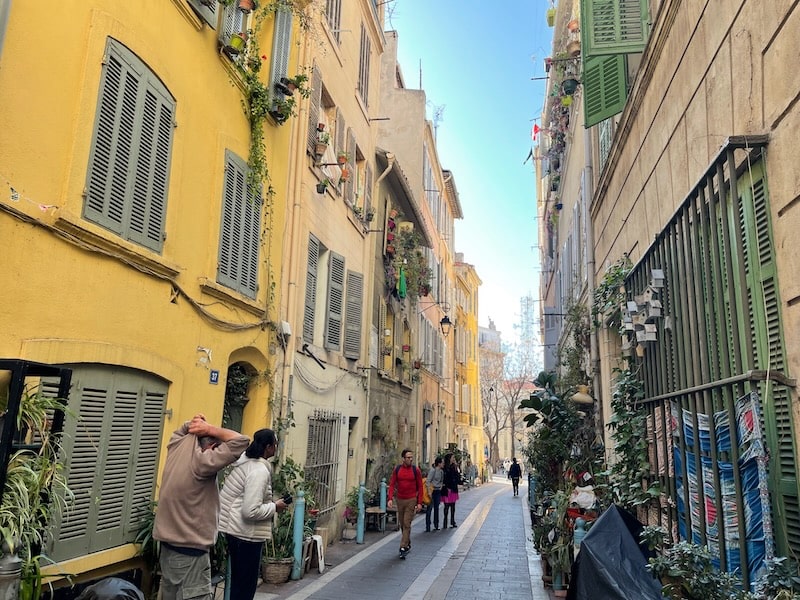 A typical street in Le Panier ©OffbeatFrance
A typical street in Le Panier ©OffbeatFranceA visit to La Vieille Charité, a striking 17th-century almshouse designed by architect Pierre Puget, should definitely be part of your visit.
Originally built as a poorhouse, it's now a cultural center and museum (and also has a clean toilet, in case you're searching).
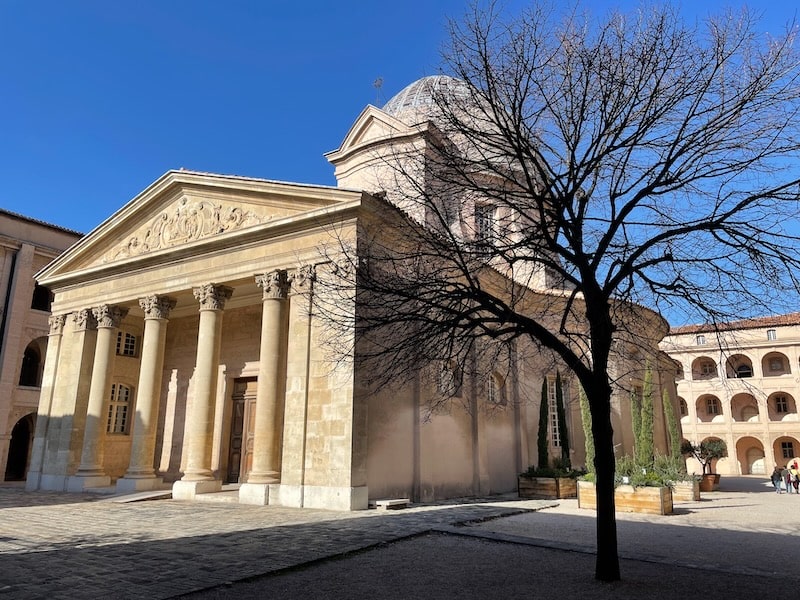 La Vieille Charité in Marseille's Le Panier district ©OffbeatFrance
La Vieille Charité in Marseille's Le Panier district ©OffbeatFranceYOU COULD TAKE A GUIDED TOUR...
If you'd like to learn more about what you're seeing, a tour like this one will fill in the blanks.
For something a bit longer, this tour covers a number of the bases − in half a day, so you still have time to see the rest!
Mucem and Fort Saint Jean
When you emerge from the Panier, you'll probably be in front of Cathédrale de La Major. I wouldn't spend too much time inside − I found it more stunning from the outside. Just before the cathedral, you might see a line on your left, for some of the best ice cream in town.
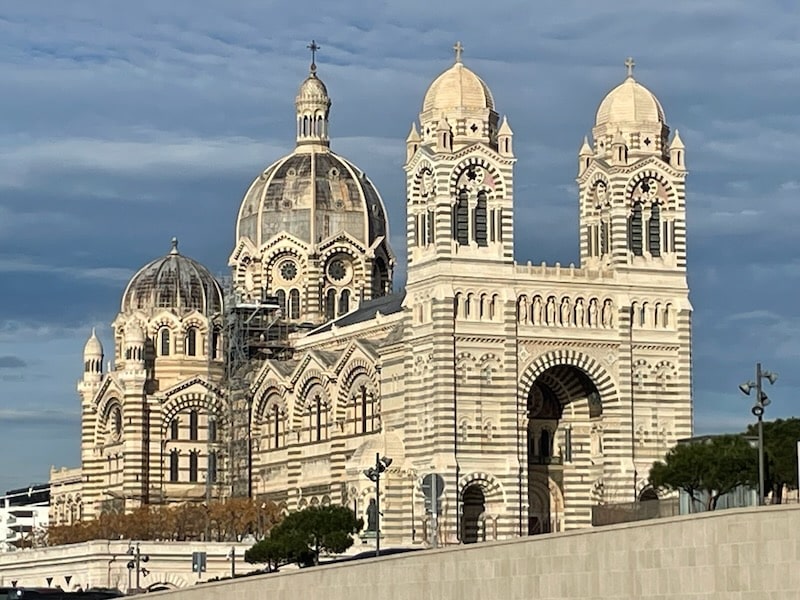 Cathédrale La Major in Marseille ©OffbeatFrance
Cathédrale La Major in Marseille ©OffbeatFranceAcross from the cathedral and to your left, follow the water back towards the Vieux Port to the Museum of European and Mediterranean Civilizations, or Mucem. It's huge and you won't be able to do it justice in an hour-and-a-half, but it's a start.
It's an architectural marvel, with a latticework façade that symbolizes the connection between land and sea, given Marseille's role as a crossroads of cultures.
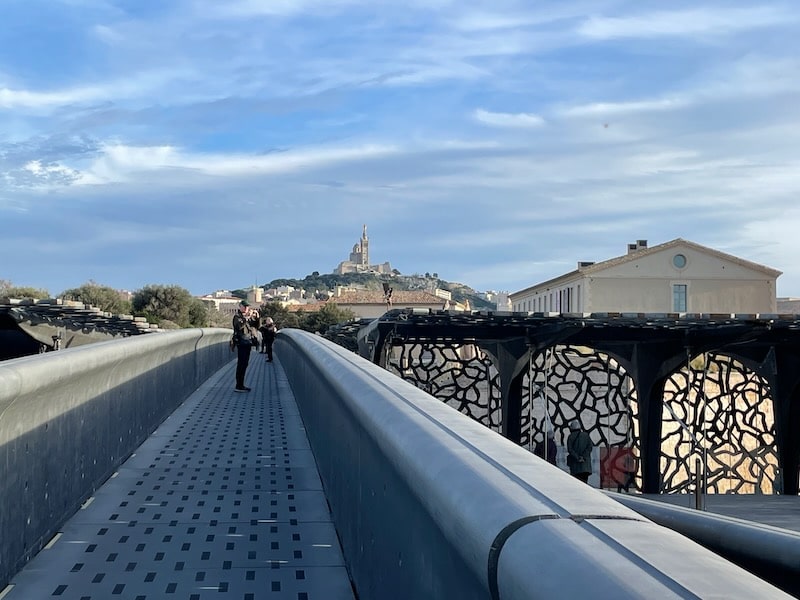 One of the walkways around the Mucem, and a closeup of the museum's lattice-work. You can see Notre Dame de la Garde on the hill beyond ©OffbeatFrance
One of the walkways around the Mucem, and a closeup of the museum's lattice-work. You can see Notre Dame de la Garde on the hill beyond ©OffbeatFranceInside, you'll find temporary exhibits dealing with different facets of Mediterranean culture, from food to history, depending on when you visit. If you're an underwater cave fan, next door is the Cosquer Museum, which replicates a prehistoric cave found underwater further along the coast.
After the Mucem, walk back into town through Fort Saint-Jean, built in 1660 by Louis XIV. Interestingly, this fort was built as a defence against attackers but also to keep an eye on the local population, to ensure their loyalty to the crown. Its walkways and gardens are a pleasure to wander around and look out over the city and sea.
Cours Julien
By now you've worked up an appetite and if you're a fan of street art, you won't want to miss the Cours Julien.
This was once the city's main fruit and vegetable market, from about 1860 to 1970, but now it is a hub for artists and creatives, with tons of street art and murals and graffiti, some of which you may like, and some of which you don't. But the area is renowned and you should see for yourself.
Even if you have limited time, you can still catch a quick lunch at one of the restaurants around the square, and explore the side streets for some street art.
The Cours Julien has a world culinary scene, with all sorts of world restaurants − Ethiopian, Palestinian, Brazilian, Indian... and French, of course. Most are small, casual establishments and if you get there early, you should easily find a table.
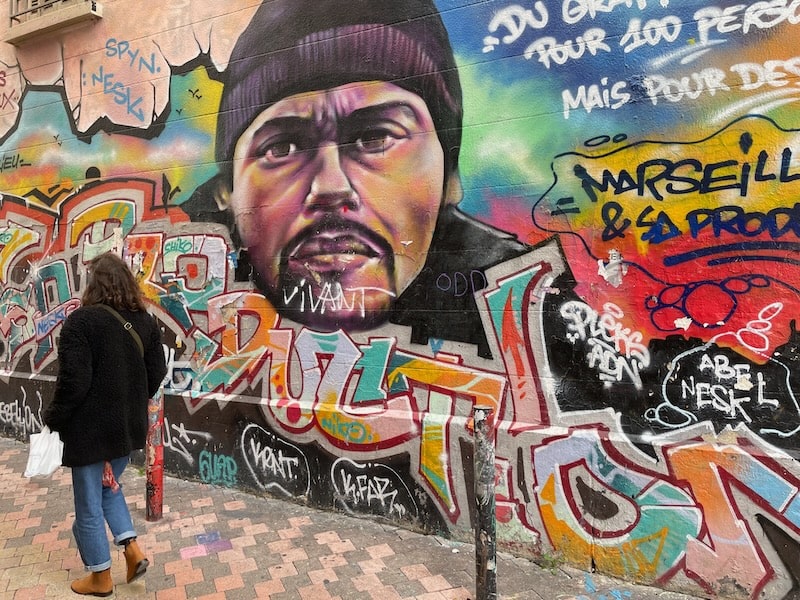 The streets around Cours Julien are filled with colorful mural art ©OffbeatFrance
The streets around Cours Julien are filled with colorful mural art ©OffbeatFranceIt's a 15-minute walk from the end of the Vieux Port, at Quai des Belges, to Cours Julien. If you're saving your energy, grab a rideshare or taxi to get here, or take the subway: Metro Line 1 at Vieux-Port towards La Rose for one stop and get off at Saint-Charles. Then transfer to Metro Line 2 towards Sainte-Marguerite Dromel and get off at Notre-Dame du Mont – Cours Julien (2 stops, approximately 5 minutes). You'll arrive right in the heart of things.
Château d’If
If you lunched in Cours Julien, you can walk back in 20 minutes to the ferry station or hop the metro back the way you came.
The timing is very tight but to me, this trip was one of the highlights of my visit to Marseille. If you've read the Count of Monte Cristo, you might feel the same.
This formidable fortress, constructed between 1527 and 1529 under King François I, was initially intended to defend Marseille from sea invasions. However, it gained notoriety as a state prison, immortalized in Alexandre Dumas' novel "The Count of Monte Cristo." Exploring its storied cells and ramparts offers a tangible connection to literary and historical narratives.
Ferries to the rocky outcrop leave every half-hour or so, but schedules vary depending on the season. Make sure you check their website, and reserve your ticket in advance. If you're on the fence about visiting the island, you can read what I had to say about the Château d'If here.
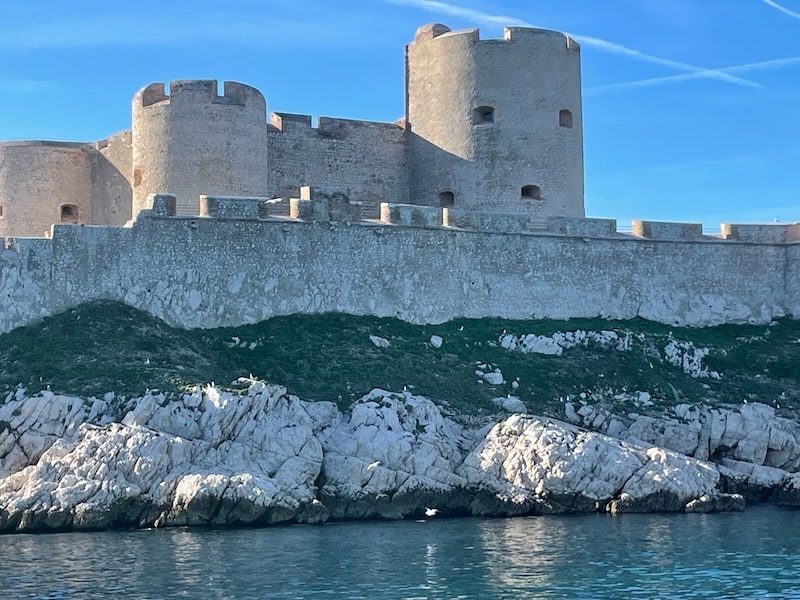 The forbidding Château d'If seen from the approaching ferry ©OffbeatFrance
The forbidding Château d'If seen from the approaching ferry ©OffbeatFranceOnce you're back from the Château d'If, you can stroll along the Vieux-Port, relax in a café, or, why not visit the Savonnerie Marseillaise, the small soap museum? As you know, Marseille soap is world famous, and this little museum shows off its history. It's tiny and won't take long, but you'll get insights into the traditional craft of soap-making, a practice deeply embedded in the city's history.
If you haven't read the Monte Cristo book or seen the movie, you might want to give the Château d'If a miss and spend more time at the Cours Julien, or head to the Palais Longchamp for some more "classical" art.
Palais Longchamp
The Palais Longchamp was also a highlight of my visit (everything in Marseille drew me so choosing is really a challenge!)
The Palais commemorates Marseille's 19th century triumph over water scarcity − and the central fountain at the entrance symbolizes abundance. Completed in 1869, it celebrates the Canal de Marseille, which channeled water from the Durance River to the city, alleviating chronic shortages.
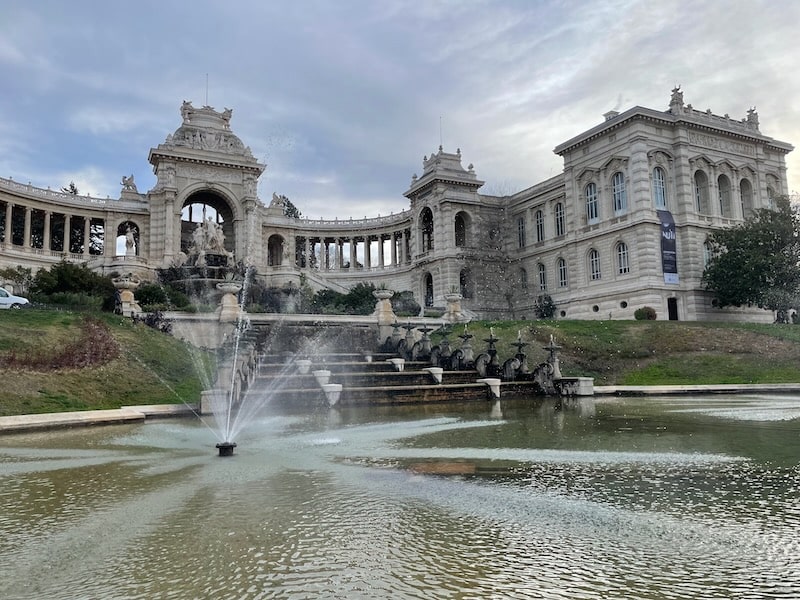 Fountains in front of the Palais Longchamp in Marseille ©OffbeatFrance
Fountains in front of the Palais Longchamp in Marseille ©OffbeatFranceArchitect Henri-Jacques Espérandieu (of the Notre-Dame de la Garde fame) designed the palace, which houses two museums: the Musée des Beaux-Arts, showcasing European paintings and sculptures, and the Muséum d'Histoire Naturelle, with natural history collections.
I visited the Beaux-Arts primarily to view several paintings related to the Great Plague of Marseille in 1720, which killed more than half of Marseille's population of 90,000 at the time.
One of the paintings, by Michel Serre, is called "View of the Port and Hôtel de Ville of Marseilles during the Plague of 1720." The is Jacques-Louis David's painting, "Saint Roch Interceding with the Virgin for the Plague-Stricken."
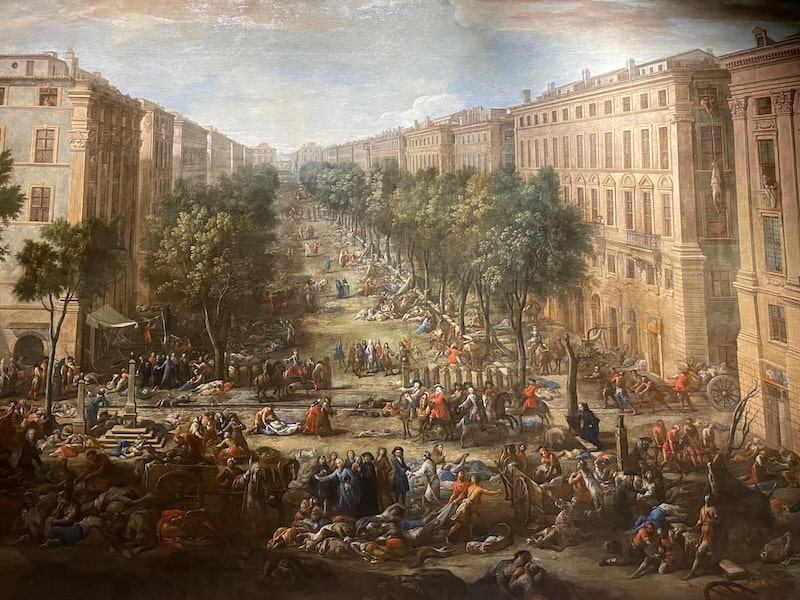 Part of Michel Serre's painting - I couldn't get the entire thing into the frame!
Part of Michel Serre's painting - I couldn't get the entire thing into the frame!An interesting aside: the observatory in the park, built in 1864, once housed the world's largest telescope, with an 80cm/32in diameter, serving as a major research facility for over 140 years.
You can take Metro Line 1 from Vieux-Port towards La Rose and alight at Cinq Avenues – Longchamp station (4 stops, approximately 7 minutes). Palais Longchamp is a short walk from the station. Just make sure you have your city GPS on because you might not see the Palais immediately.
Or, walk up the iconic Canebière, which the Marseillais consider their equivalent of the Champs-Elysées, and hop the T2 tram for four stops and get off at Longchamp.
Dinner at Chez Fonfon
If I'm suggesting this particular restaurant, it's only to get you out to the Vallée des Auffes and the Corniche, which you won't otherwise see unless you take the Hop On Hop Off bus.
Chez Fonfon is renowned but recently has suffered from many poor reviews for service. It's an expensive restaurant, so it matters. I can't judge, not having tried it myself. You can reserve here and you can read reviews here.
I chose Chez Madie les Galinettes (here's their Facebook page) along the Vieux-Port, also a bit pricey (most are) because I'd already visited the Corniche and wanted something nearby. It was quite good, even though I had nothing I could compare it to.
Le Ruhl and Chez Michel also have good reputations, as do Chez Loury and the Miramar along the Vieux-Port.
If you go to Chez Fonfon, you'll be able to enjoy a walk back from the quaint fishing harbor of the Vallon des Auffes to town, along the glorious Corniche promenade.
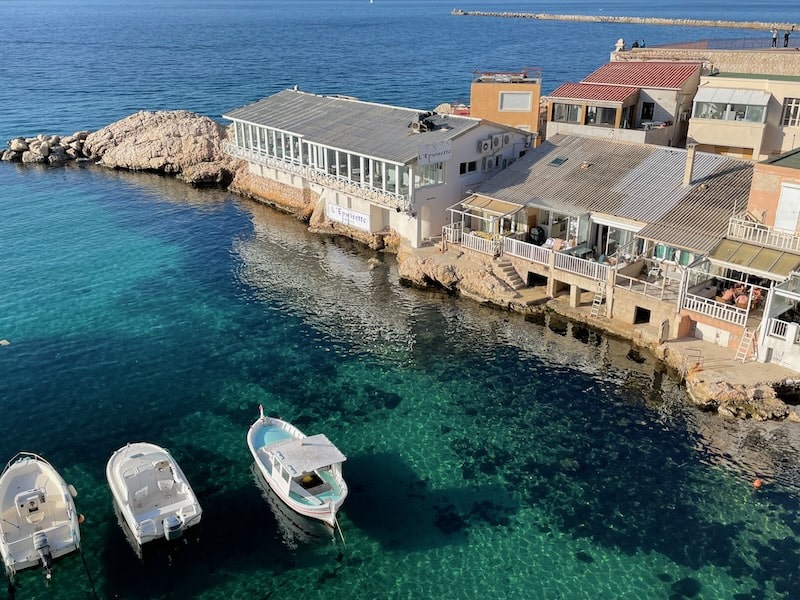 Vallon des Auffes in Marseille
Vallon des Auffes in MarseilleThe way back is normally via Bus 83 but I've found it to be overcrowded in the evenings, so much so that it sometimes doesn't stop. It's a ten-minute walk to the Plage des Catalans at the edge of Marseille, or half an hour all the way to the Vieux-Port. The area is well lit and highly frequented, especially on summer evenings.
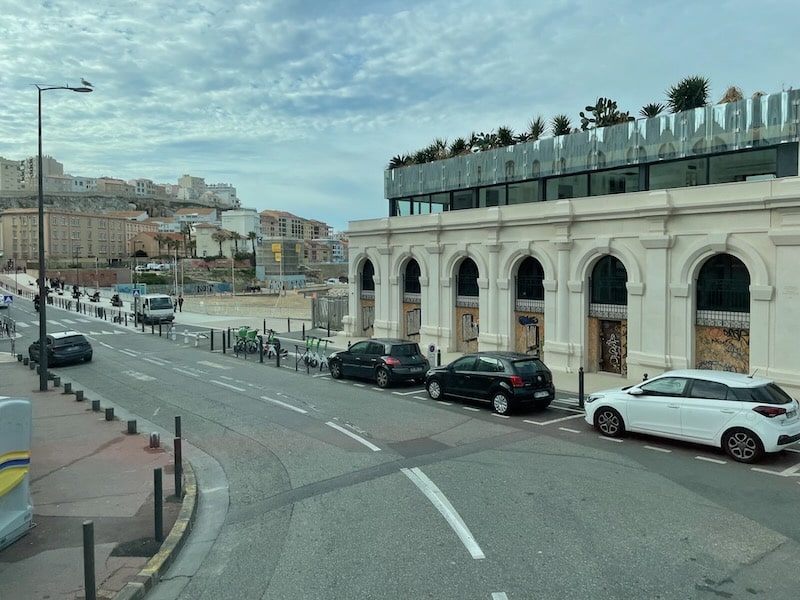 The Plage des Catalans, at the edge of Marseille, along the Corniche Kennedy, which stretches along the sea for 3 kilometers (1.8 miles) ©OffbeatFrance
The Plage des Catalans, at the edge of Marseille, along the Corniche Kennedy, which stretches along the sea for 3 kilometers (1.8 miles) ©OffbeatFranceNOT IN THE MOOD FOR BOUILLABAISSE?
A great option is this evening food tour that takes you around the Cours Julien, so if you're not having lunch among the street art, you can still catch it in the evening.
Another option, if you'd like to stay near the Vieux Port, is a stroll along the Cours Honoré-d'Estienne-d'Orves, a pedestrian street full of cafés and restaurants that runs parallel to the south side of the port.
Getting around Marseille
Marseille has excellent public transportation and you can get around to all the places on this itinerary by using the city network.
You can buy tickets individually, get a 24h transport pass, or buy a full-day Marseille CityPass, which includes both transportation and many of the city's attractions, including its museums.
Given that you only have a day, you might consider taking a Hop On Hop Off tour of Marseille. I tried it for a day and taking the bus gave me a good sense of the city's layout. It also made getting around a bit easier, especially to neighborhoods with less public transportation.
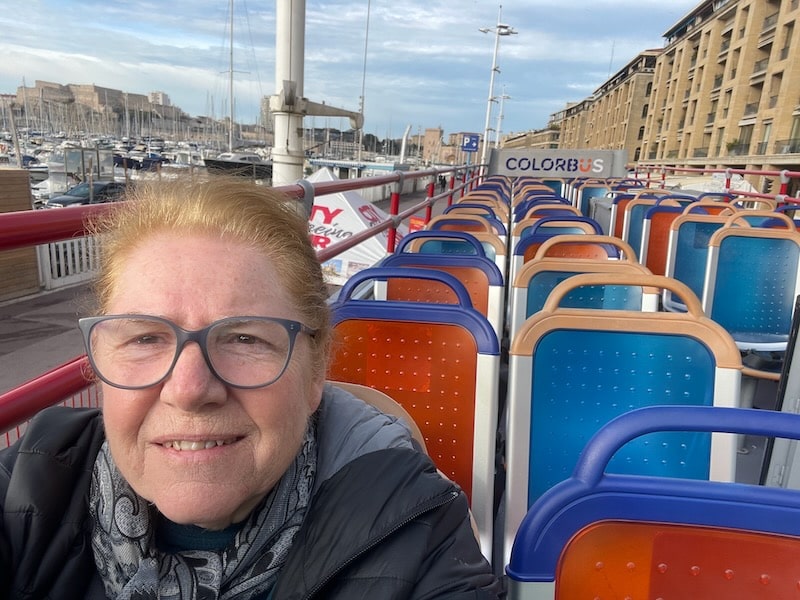 On this trip it was winter and as you can see, I didn't have to fight for the best seat! ©OffbeatFrance
On this trip it was winter and as you can see, I didn't have to fight for the best seat! ©OffbeatFranceTravel tips for one day in Marseille
- Do not drive. Seriously. If you arrive in Marseille with a rental car, park it for the day and pick it up when you're done. Parking is difficult, and driving here requires a serious set of nerves.
- If you're planning on eating a bouillabaisse, make a reservation. Depending on the time of year, the best restaurants can be crowded.
- Do you get seasick? If you do, bring along a couple of anti-nausea bracelets or pills for the boat trip to the Château d'If.
- Make sure you have some kind of map. Use a physical one, or download the Marseille map from Maps.me or Google Maps.
- Be aware that Marseille is often considered less safe than other large French cities. Safety is relative, however, so read this piece for the real safety situation in Marseille.
- As is the case throughout France, it’s always good to be aware of local etiquette, the one and only compulsory issues being “hello” and “goodbye” when you enter and leave a shop (bonjour and au revoir). You can download these basic phrases in French – very few but very useful.
- Marseille offers a 24-hour pass for unlimited access to buses, trams, and the metro, which can be convenient for this itinerary.• Advance Reservations: Consider booking tickets in advance for the boat trip to Château d’If and dinner at Chez Fonfon to ensure availability.• Palais Longchamp Opening Hours: The park is open daily from 9:00 AM to 8:00 PM. The museums within the palace typically operate from 10:00 AM to 6:00 PM. Ensure your visit aligns with these hours.• Time Management: Be mindful of the time spent at each location to adhere to the schedule, especially considering travel
Before you go…
Can you spend more than one day in Marseille?
If so, you can see more of the city, or get out town on one of these day trips from Marseille. A great place to start would be the Calanques National Park, a series of glorious rocky inlets along the coast.
Although you can absolutely see the highlights in one day, please try to stay longer − this is such an incredibly vibrant city that you'll be doing everything you can to come back!
Did you enjoy this article? I'd love if you shared it!
